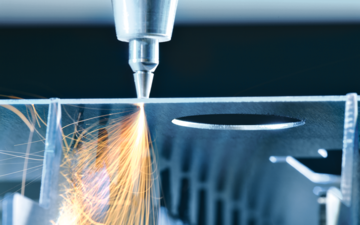- Official BOC UK Online | Industrial Gases | Products & Solutions | BOConline UK
-
Shop
- Industries
- Processes
- Gases & Equipment
-
Solutions
-
Services
-
Health & Safety
-
Contact & Support
- What's Happening
-
Net Zero Strategies
Laser Gases: Three Critical Questions when Choosing your Gas Supply
Posted by BOC

Are you new to laser cutting? Buying a laser cutting machine for the first time – or simply looking into your gas supply options? In this blog, we run through your options and the main questions to consider when choosing your assist gases supply.
Question 1: Which laser assist cutting gases do I need?
Traditionally, it was only possible to buy CO2 lasers that offered a maximum power output of 4-5kW. Mild steel would always be cut with oxygen, and stainless steel and aluminium would be cut with nitrogen.
The reason is quite straightforward – mild steel combusts with oxygen, creating a great deal of additional heat, which produces a significant increase in laser cutting speed. But it doesn’t work with stainless steel – instead oxygen results in a bad cut, without any increase in speed. Nitrogen, however, offers a clean, unoxidised cut, albeit at a lower speed.
Today, laser cutting machines are available at a much higher power output, of 15kW or more. At this capacity, it’s possible to cut mild steel much faster with nitrogen than oxygen (the only exception being very thick mild steel of 8-12mm.) For modern, high power fibre lasers, it means that oxygen is confined to a small proportion of materials cut.
So now, the emphasis is on nitrogen for assisted laser cutting.
Question 2: Why should I consider liquid nitrogen?
BOC produces liquid nitrogen and liquid oxygen in large, reliable industrial plant called air separation units.
The main advantage of producing industrial gases in this way is the consistent purity – liquid nitrogen is 99.999% minimum purity – as well as the efficiency of the process. No other high purity nitrogen production process is as efficient as air separation. For laser cutting, it means a guarantee of pure gas when it matters most; when an unoxidised edge is of critical importance.
It’s delivered directly to you from the production plant and then, depending on the size of your site and the amount of gas you need can be kept in an on-site liquid nitrogen vessel.
Liquid nitrogen vessels are very flexible and ideally suited for use with laser cutting operations where the assist gases needs are often highly cyclical.
The design of the vessels themselves has evolved over almost a century of industry use. Heat ingress is almost zero thanks to perfect insulation, meaning the liquid nitrogen inside remains cool even during the hottest weather. And as tanks have no moving parts, they are highly reliable – a critical factor for any contract laser cutting business where even a few hours of downtime can cost thousands in lost revenue. Though they’re expensive to manufacture, because of their very long life (lasting for decades) and very low maintenance requirements, they can be rented at an extremely competitive cost.
BOC has a nationwide distribution fleet offering unrivalled coverage. Our on-site vessels can optionally be fitted with telemetry, which automatically notifies BOC when a refill is required – meaning our laser cutting customers can be topped up without even contacting us.
Question 3: What volume of gas supply would suit me best?
It sounds simple enough – just match your gas supply to the amount of material you intend to cut.
But there are lots of factors that can impact on your usage. The type of work you’re undertaking; the material (e.g. stainless steel, mild steel or aluminium) and the thickness of the material you’re working with will determine the type of gas, the purity, and the pressure and flow rate required.
Changing your material, even by the slightest difference in thickness, or ramping up your cutting activity, can have a significant impact on your supply needs.
If you are new to laser cutting and aren’t sure how much assist gas you will need, speak with your chosen laser equipment supplier or speak to a BOC industry expert.
At BOC, we have a deep understanding of the laser cutting process and the modern fibre laser cutting machines in use today. Equipped with the knowledge of how your business operates; the amount of cutting you’re doing, your shifts and materials, we can work with your equipment provider to make a good estimate of your assist gases usage.
However, it’s always worth testing first. We suggest that new customers start with MCPs (cylinder bundles). Then we accumulate and analyse the data on your usage and propose a cost-effective vessel solution that works for your needs today – and your plans for the future.
Could you benefit from a call with a laser cutting gases expert?
If you would like to find out more about your laser cutting gas assist options, request a callback from a BOC industry expert.
